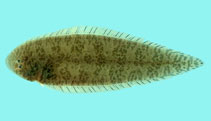| Family: |
Cynoglossidae (Tonguefishes), subfamily: Cynoglossinae |
| Max. size: |
35 cm SL (male/unsexed) |
| Environment: |
demersal; freshwater; brackish; marine; depth range 1 - 140 m |
| Distribution: |
Indo-West Pacific: India eastward to the Malay Archipelago and the South China Sea, southward to the Philippines and northwest Australia; eastward to New Guinea (Ref. 9895). A related species, Cynoglossus gilchristi Regan, 1920 is recorded from Madagascar, the holotype (BMNH n°1903.9.29:2) being from Natal, off Umlanga River (Ref. 6806). |
| Diagnosis: |
Dorsal spines (total): 0-0; Dorsal soft rays (total): 90-100; Anal spines: 0-0; Anal soft rays: 72-78; Vertebrae: 44-49. Ocular side yellow-brown. Dorsal and anal fins joined to caudal. Eyes both on the left side of the body, a narrow space separating them; asymmetrical mouth; rostral hook below mouth. Ocular side with 2 lateral lines. Only the left ventral fin present (Ref 28). With very irregular dark brown blotches, often forming irregular cross bands. Some rays of dorsal and anal fins dashed with dark brown. Scales ctenoid on both sides of body. Midlateral-line scales 78 to 99. Scale rows between lateral lines on eyed side 15 to 19 (Ref 9895). |
| Biology: |
Found on the continental shelf over sandy and muddy bottoms. Occurs in the lower courses of flowing rivers and in estuaries (Ref. 12693, 48637). Feeds mostly on benthic invertebrates. Sold fresh, frozen, or dried salted in markets (Ref. 6806). |
| IUCN Red List Status: |
Least Concern (LC); Date assessed: 14 August 2019 Ref. (130435)
|
| Threat to humans: |
harmless |
Source and more info: www.fishbase.org. For personal, classroom, and other internal use only. Not for publication.

